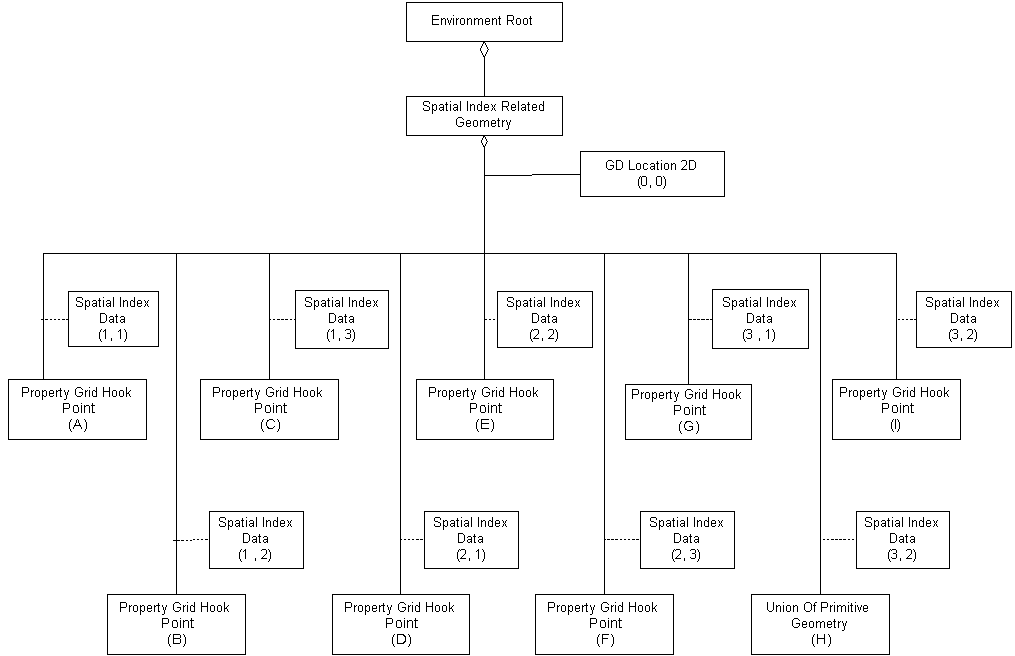The SEDRIS Data Representation Model
APPENDIX A - Classes
Spatial Index Related Geometry
|
|---|
Class Name: Spatial Index Related Geometry
Subclasses
This DRM class is concrete and has no subclasses.
Definition
An instance of this DRM class specifies an aggregation of
<Geometry Hierarchy> objects in
which each component <Geometry Hierarchy>
represents a different tile within a spatially indexed (tiled) organization
of <Primitive Geometry> objects within a
SEDRIS transmittal. The
<Spatial Index Data> link object
attached to each component
<Geometry Hierarchy> indicates the tile that
it represents.
Primary Page in DRM Diagram:
Secondary Pages in DRM Diagram:
This class appears on only one page of the DRM class diagram.
Example
See
<<Spatial Index Organizing Principle>>, example #1.
Consider an <Environment Root>
describing a terrain surface that is a mix of grids and polygons,
organized by spatial indexing into 9 cells.
All cells except H are grids (represented in SEDRIS as
<Property Grid> instances) captured at 1
level of detail. Cell H consists of <Polygon>
instances.

Please note that the components of the
<Spatial Index Related Geometry>
are not ordered; the <Spatial Index Data>
is used to identify the individual tiles.
FAQs
- What is the purpose of this class?
This class allows <Geometry> objects to be
organized (tiled) according to some spatial index.
-
My data consists of terrain <Polygons> that are
tiled along the lines of a grid, but some <Polygons>
here and there cross over tile boundaries. Can I organize these
<Polygons> with a
<Spatial Index Related
Geometry>?
Yes, if its strict_organizing_principle is set to
SE_FALSE to indicate
that the indexing is not strictly followed (see
<<Spatial Index Related
Organizing Principle>>, example #1). Each tile of the spatial index would
be represented by a <Geometry Hierarchy>
component of the <Spatial Index
Related Geometry>.
- Where is the origin of the spatial index?
The required <Location> component of the
<Spatial Index Related Geometry>
specifies the origin of the spatial index, which is its lower-left
corner.
Constraints
Associated by (one-way)(inherited)
Associated with (two-way)(inherited)
Composed of (two-way)(inherited)
Composed of (two-way)
Composed of (two-way metadata)(inherited)
Component of (two-way)(inherited)
Notes
Associated with Notes
An association between a <Geometry Hierarchy> instance and a
<Feature> instance indicates that the <Geometry Hierarchy>
and the <Feature> are alternate representations of the same
environmental object.
An association between two <Geometry Hierarchy> instances
indicates that they are alternate representations of the same
environmental object.
An association from a <Hierarchy Summary Item> instance to a
<Geometry Hierarchy> indicates that the <Hierarchy Summary Item>
summarizes that <Geometry Hierarchy>.
An association from a <Reference Surface> instance to a
<Geometry Hierarchy> indicates that the <Geometry Hierarchy>
organizes the geometric objects that specify the resolution
surface of the <Reference Surface>.
Composed of Notes
In the case where multiple <Collision Volume> components are
specified for a given <Aggregate Geometry>, the union of the
volumes thus specified is used in collision detection.
This is the origin of the collection, which is the lower-left corner.
Fields Notes
If this value is SE_TRUE, each 'descendant' of this aggregation -
that is, each <Geometry> instance that exists in the component tree
rooted at the given <Aggregate Geometry> - shall be unique, in the
sense that it shall appear in only one 'branch' of this aggregation.
If unique_descendants is SE_FALSE, at least one <Geometry> instance
appears in more than one 'branch' of the aggregation.
If this value is SE_TRUE, each 'branch' of this aggregation
strictly complies with the organizing principle for its
particular subclass. If this value is SE_FALSE, at least
one 'branch' does not strictly comply with the given
organizing principle. See the organizing principle constraint
for each specific subclass for details.
If this value is SE_FALSE, all column and row entries are present;
otherwise one or more entries are not present.
This is the length of a cell in the given unit along the X axis.
This is the length of a cell in the given unit along the Y axis.
Prev: Spatial Index Related Features.
Next: Spatial Index Related Geometry Topology.
Up:Index.
|
Last updated: May 15, 2003
|
Copyright © 2003 SEDRIS™
|
|
